EDITOR’S NOTE: Traveleater and Austrian food expert Ana Raicic shares with us 20 traditional dishes you need to try on your next trip to Vienna and Austria.
Austria is a country in Central Europe, bordering Italy, Slovenia, Switzerland, Hungary, Slovakia, Czechia, Liechtenstein, and Germany.
Historically, it was connected to Germany, Hungary, Bohemia, the Balkans, and northern Italy through the Habsburg dynasty and the empire they presided over. The Habsburg monarchy reigned the lands of Austria, parts of Hungary, and parts of the Balkans from 1282 all the way to the end of WWI in 1918.
This multicultural empire with its court in Vienna transformed the Austrian capital into a cultural melting pot of dignitaries and common folk. People from across the empire flocked to Vienna, bringing with them their language, traditions, and best of all, their food.
FOOD IN AUSTRIA QUICK LINKS
If you’re visiting Austria and want to learn more about Austrian food, then you may want to go on a food tour.
TOURS
- Austrian Food/Drinking Tours: Food and Drinking Tours in Austria
Save This on Pinterest!
No time to read this article on classic Austrian foods? Click on the save button and pin it for later!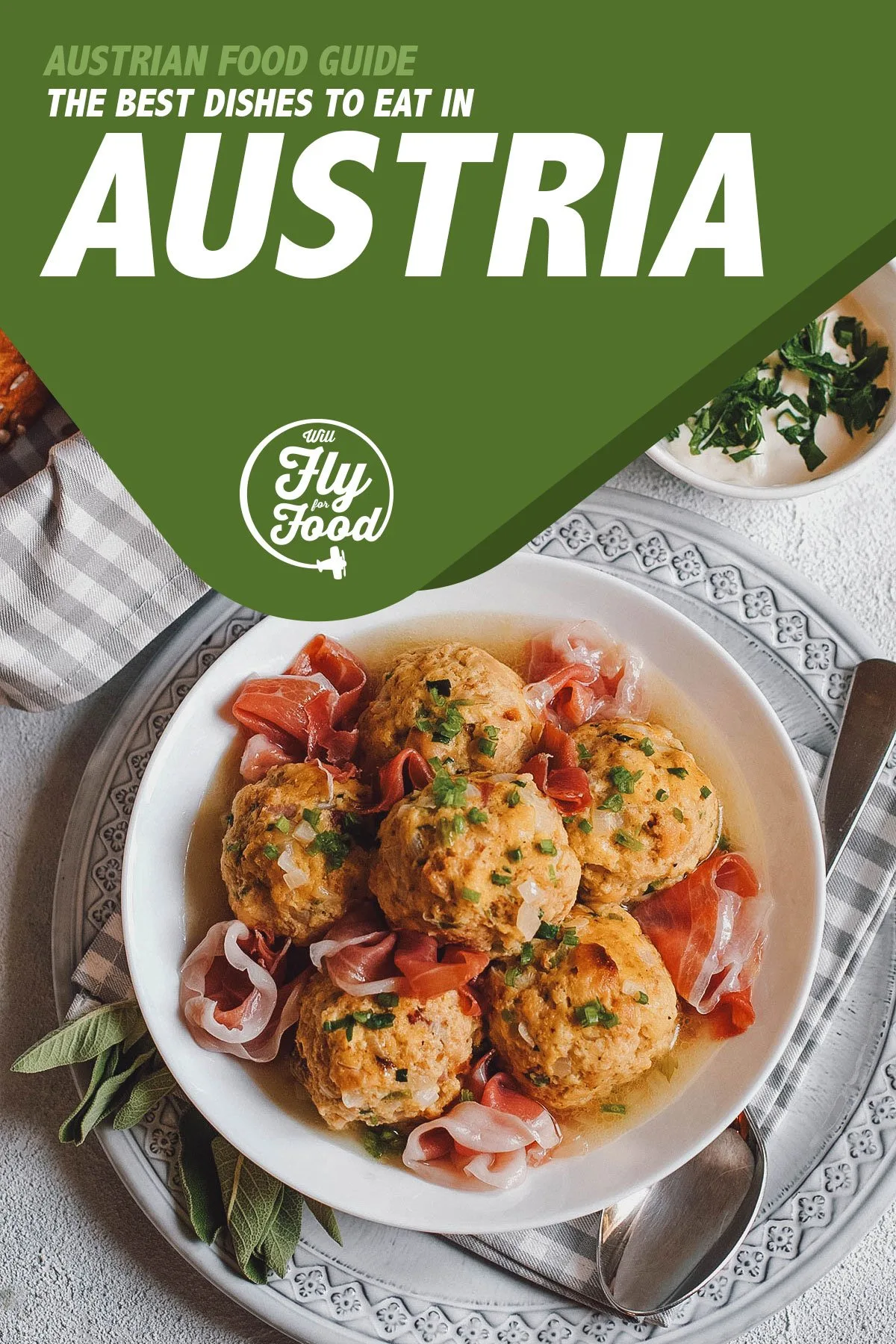
Photo by OlgaBombologna
WHAT IS TRADITIONAL AUSTRIAN CUISINE?
Austria is a large country, shaped by its neighbors and the nations under the Habsburg monarchy. The Austrian food of today is regionally varied, with distinct regional cuisines that have developed throughout history.
Austrian food culture is heavy on proteins and carbs, with the most popular meats being beef, pork, chicken, turkey, and goose. There’s a special place in Austrian kitchens for game, as Austrians were traditionally avid hunters. Many Austrian dishes use the entirety of the animals, including the offal, snout, and trotters.
Traditional Austrian meat dishes include the ever-famous wiener schnitzel, sausages, and cured meats – the most Austrian being speck. Some sausages originate from different parts of the empire.
Sausages are usually consumed as a snack or as part of a larger meal. Some famous Austrian sausages originating from other parts of the Habsburg monarchy include the carniolan sausage, from the region of Carniola in Slovenia, and the debreziner from Debrecen in Hungary.
Popular Austrian snacks include open-faced sandwiches filled with various cuts of meat. Wurstsemmel are made with sausages, leberkase rolls contain leberkase, while schnitzelsemmeln feature steak. Bosna, an Austrian spicy hotdog roll, is another favorite.
Austria is well known for its sweet dishes – be it cakes, pastries, or other desserts. Who hasn’t heard of the great sachertorte or linzertorte? Or the little biscuits that go with coffee and tea that became known as viennoiserie in French?
As you’ll see in this guide on popular Austrian foods, Austria desserts are highly varied. You’ll find fruit-based desserts like marillenknödel, Austrian-style crepes called palatschinken, delicious doughnuts, and tasty biscuits – the most famous being vanillekipferl.
Jams of various kinds are prominent, with apricot, berry, apple, and plum being the most popular. Nuts are also a common ingredient and often mixed with flour for flavor and texture.
MUST-TRY AUSTRIAN DISHES
This article on traditional Austrian food has been organized by category to make it easier to go through. Click on a link to jump to any section of the guide.
SOUPS / SIDES / BREAD
1. Frittatensuppe
Frittatensuppe is a type of Austrian pancake soup made with a strong aromatic beef broth and pieces of savory crepe-style palatschinken.
The beef broth is prepared by boiling root vegetables, onions, and beef bones together in water. The broth is simmered for at least an hour and then strained. For the frittaten, a thin layer of crepe-style batter is pan-fried and cut into thin strips before being served in the broth.
Frittatensuppe is a very traditional starter dish in German and Austrian cuisine. Because it’s a soup, it’s especially suited for cold winter days. It’s commonly found in traditional restaurants and inns throughout Austria so there’s no shortage of places for you to try it.
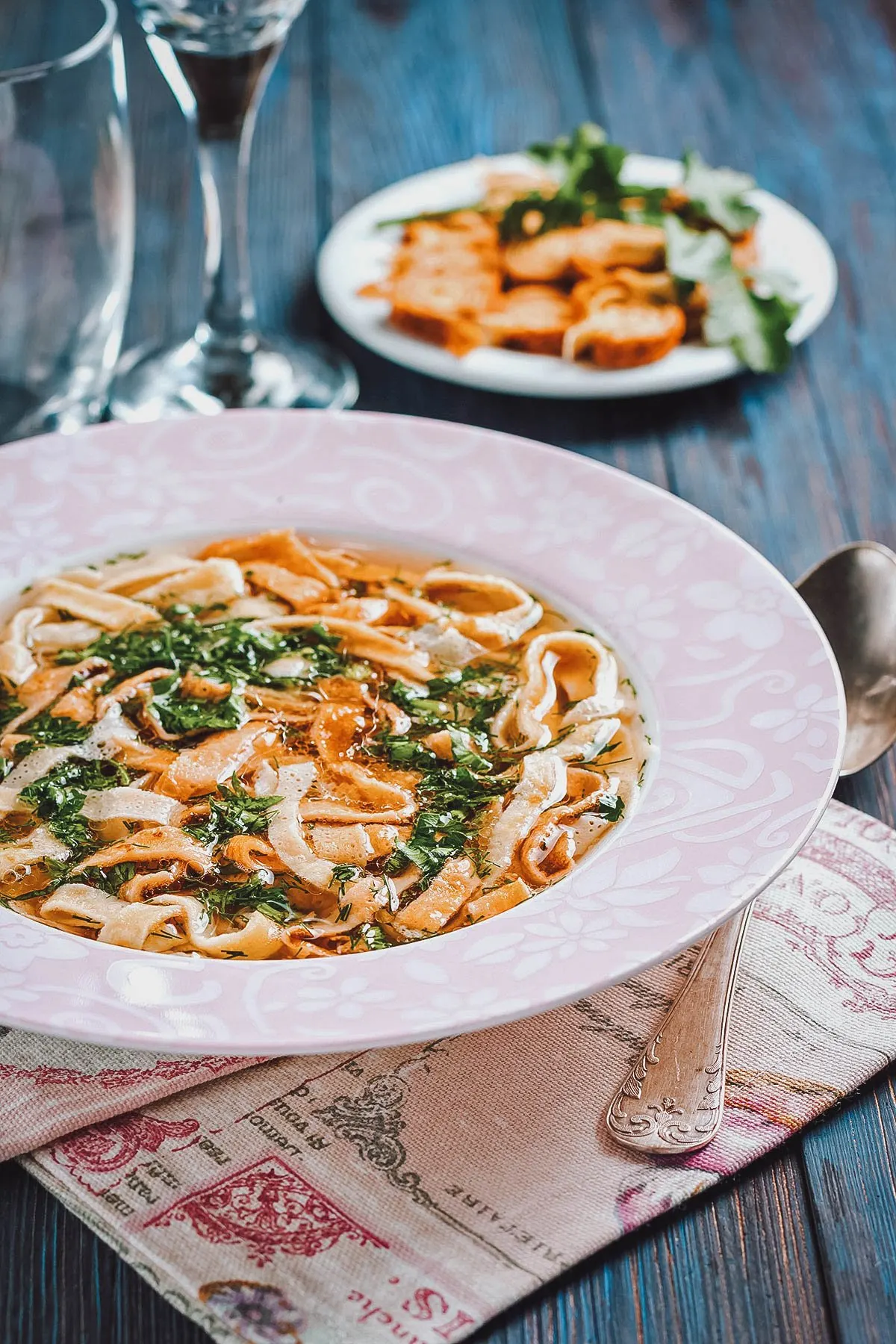
Photo by SEAGULL_L
2. Käsespätzle
Käsespätzle is a traditional dish originating from the Württemberg, Baden, Allgäu, Tyrol, and Vorarlberg regions. Known by many names, it’s traditionally prepared by grating hard cheese into hot spätzle and alternating layers of spätzle, cheese, and roasted onions.
The cheese used in käsespätzle varies by region. Some commonly used cheeses include emmental, montafon sura kees, limburg, and weißslacker.
Käsespätzle is usually served with a side of salad or potato salad. In Vorarlberg, it’s commonly served with apple sauce.
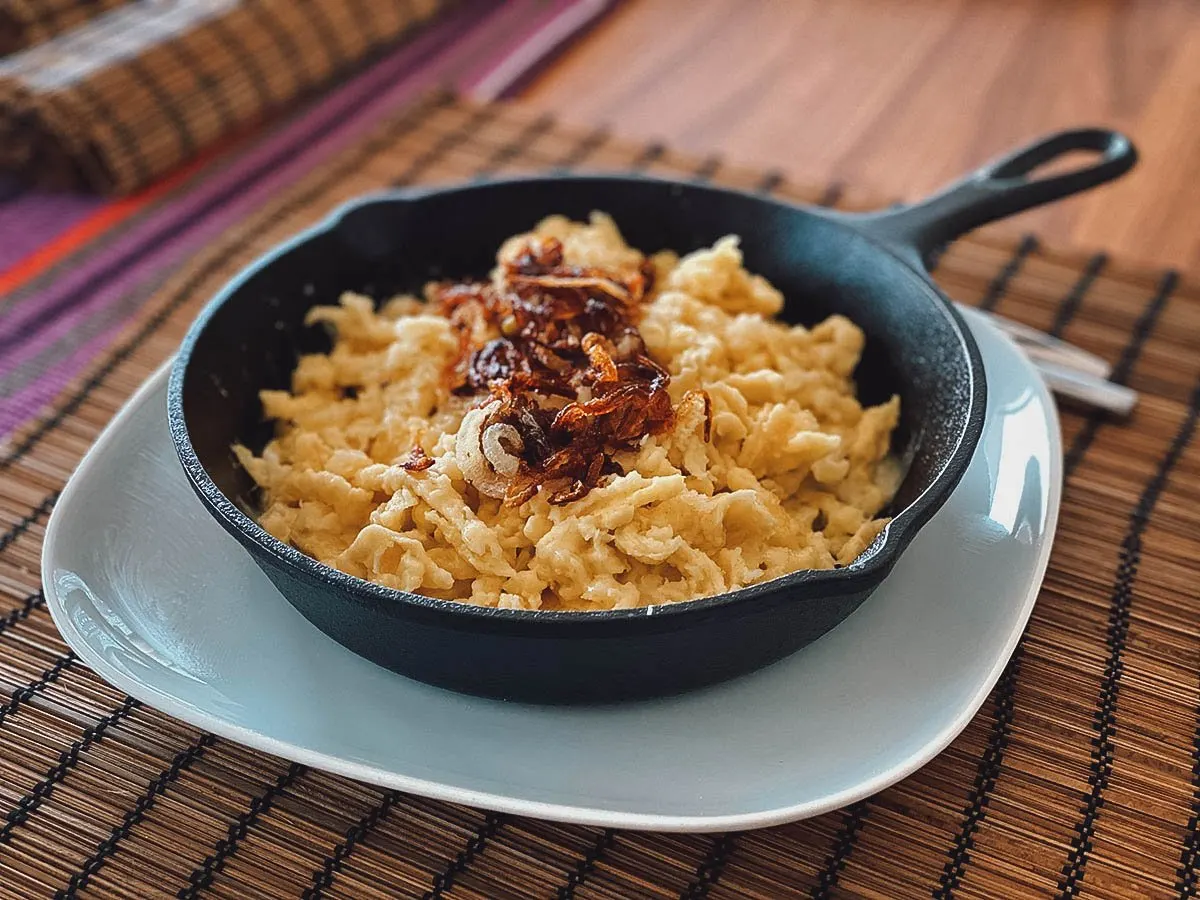
Photo by fivetonine
3. Tiroler Gröstl
Tiroler Gröstl is a Tyrolean dish made in a pan, usually with fried potatoes, strips of meat, chopped onions, and mushrooms. It was developed as a way of using up Sunday roast leftovers on Mondays.
All ingredients are fried in a pan and seasoned with salt, pepper, marjoram, caraway seeds, and parsley. The dish is usually served with a fried egg on top.
Tiroler gröstl is especially common in its region of origin – Tyrol – but it can be found throughout Austria. It’s a typical Austrian breakfast served at local restaurants, mountain huts, and ski chalets in the Austrian Alps.
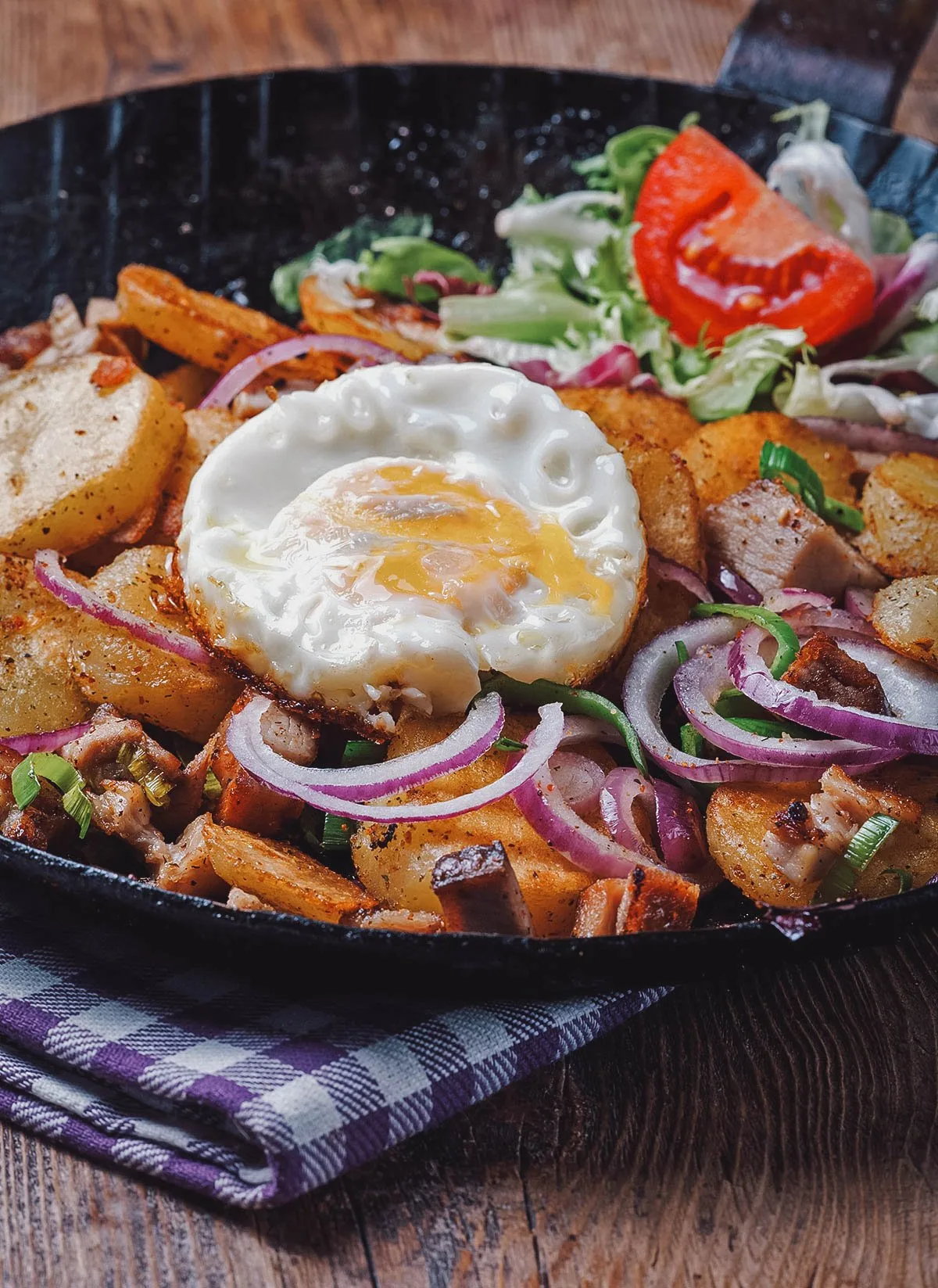
Photo by Bernd Juergens
4. Tiroler Knödel
Like gröstl, tiroler knödel refers to an Austrian dish that originated in Tyrol. They’re traditional bread dumplings made with cubed bread, eggs, milk, onions, parsley (or chives), nutmeg, and salt. The ingredient that makes this dumpling Tyrolean is speck (Austrian cured bacon).
Tyrolean dumplings are traditionally made in a ball shape and cooked in boiling water. They can be served in a soup – as a Tyrolean dumpling soup – or more commonly as a side dish. They can be served as a main course with sweet or sour cabbage as well. When served as a side dish, they’re doused in melted butter which adds richness and mellows out the flavor of the speck.
As you’d expect, these dumplings are very common in Tyrol. If you’re vegetarian, then you can try their vegetarian cousin – the faschtnknödel – during lent. It’s a version of knödel that leaves out the speck.
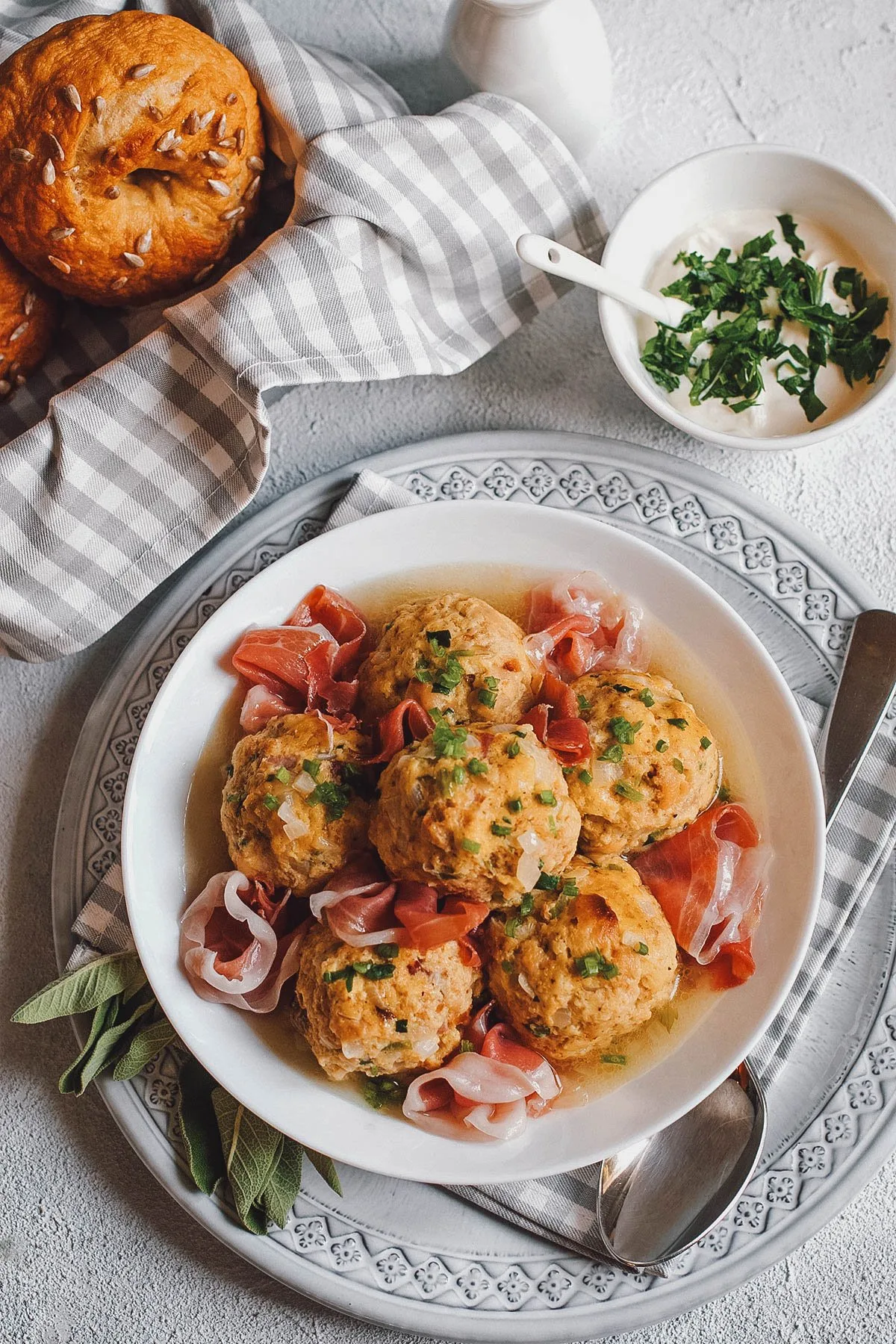
Photo by OlgaBombologna
5. Erdäpfelsalat (Austrian Potato Salad)
Erdäpfelsalat is an Austrian potato salad made with waxy whole potatoes that are peeled and sliced after cooking. Austrian potato salad is traditionally served with meat dishes and is very common on the menus of many restaurants throughout Austria.
To prepare, the potatoes are cooked with the skin on before being peeled and sliced. Chopped onions are then pan-fried in butter and deglazed with vinegar. Broth is added to the fried onions and left to boil for a couple of minutes before being poured over the slightly cooled potato slices. The potatoes are flavored with mustard, oil, and salt and then left to rest for at least half an hour to soak up the dressing.
When ready, erdäpfelsalat can be served warm or cool, often with a sprinkling of chopped parsley.
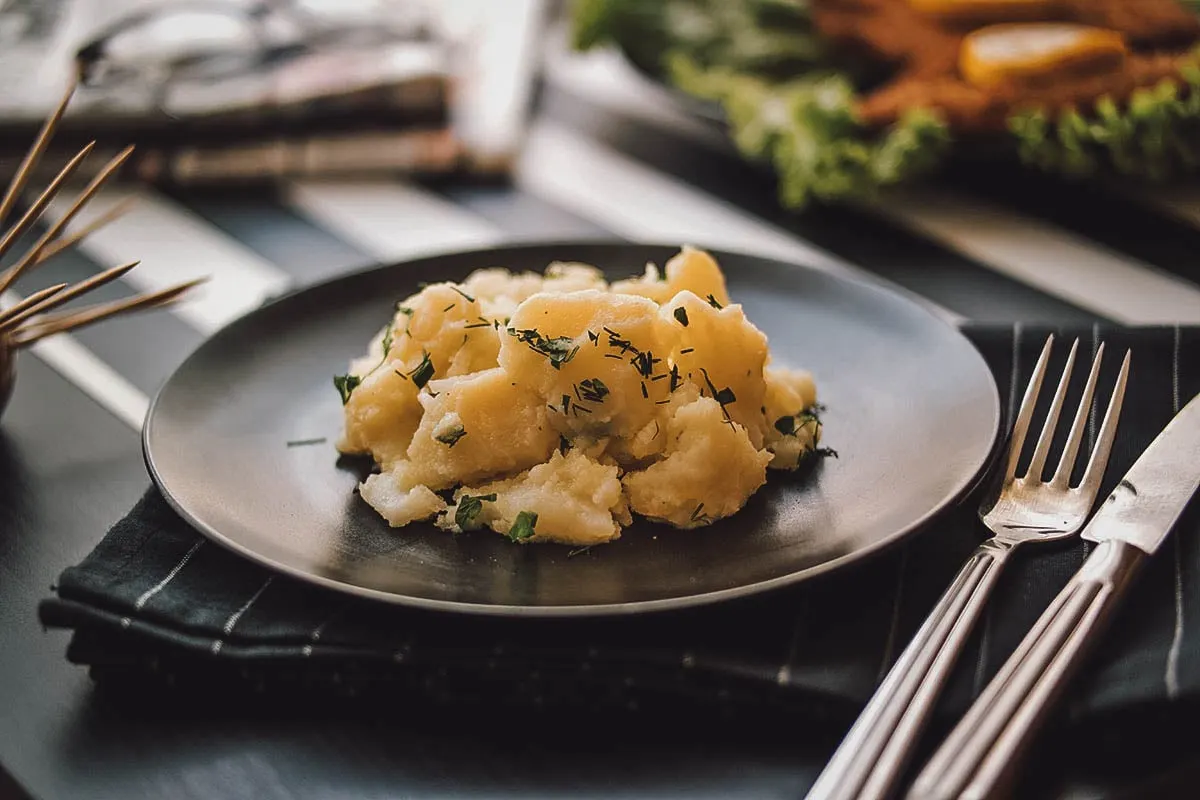
Photo by Alp Aksoy
6. Kaisersemmel
Kaisersemmel refers to a small and round crusty bread roll with a traditional star shape on its surface. These bread rolls are extremely common and can be found in nearly every bakery and supermarket in Austria.
These crusty bread rolls are used to make Austrian breadcrumbs. They’re also a common ingredient in bread dumplings, bread soup, and open-faced sandwiches.
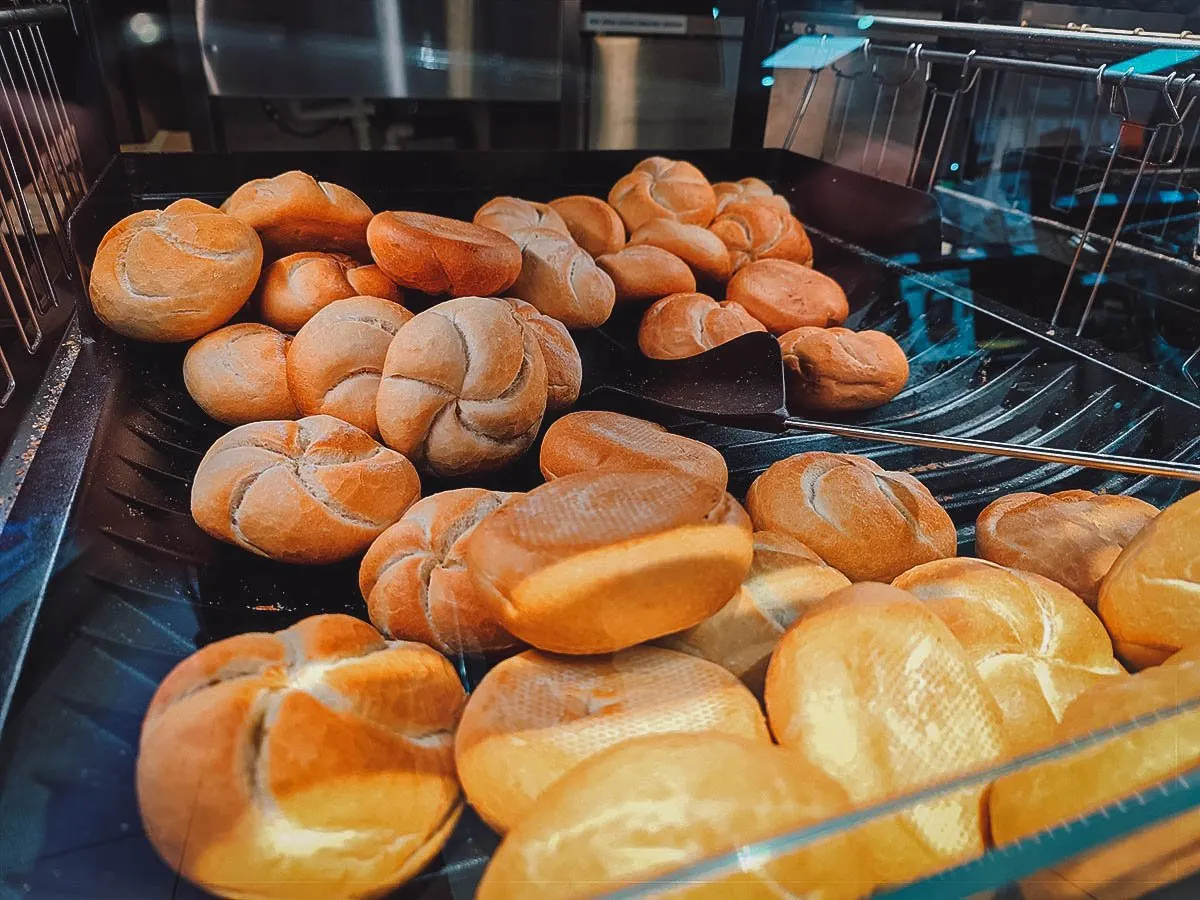
Photo by JGLmarket
MAINS
7. Wiener Schnitzel
No list of the most popular Austrian foods can ever be complete without wiener schnitzel, the national dish of Austria.
A wiener schnitzel is a fried dish consisting of a thin, breaded fried cutlet. It comes from Vienna – where it’s called Vienna schnitzel – and is one of the most recognizable dishes in Austrian culture and cuisine.
The most important aspect of the wiener schnitzel is its thickness, or lack thereof. It needs to be extremely thin so it fries nicely and is easy to eat. The cutlet needs to be sliced or pounded to a thickness of about 4mm.
To prepare, the cutlet is first coated with flour, then whipped eggs, and finally breadcrumbs. It’s important that the breadcrumbs aren’t pressed into the meat so they stay dry and become crumbly when fried. The cutlet is then pan-fried in lard or clarified butter till golden brown.
Wiener schnitzel can be served with a variety of side dishes – green salad with a sweetened vinaigrette dressing, potato salad, cucumber salad, parsley potatoes, or french fries. It’s common at nice restaurants and country inns throughout Austria so it shouldn’t be hard to find.
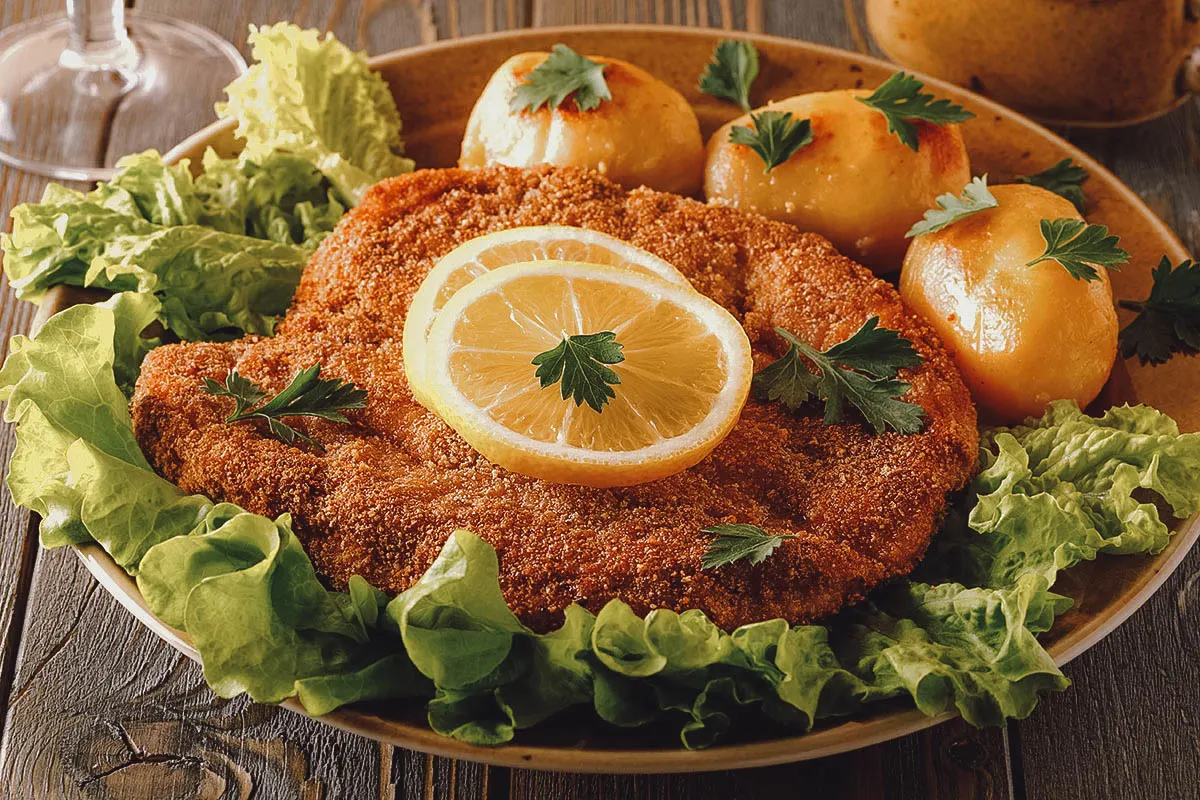
Photo by Tatiana Bralnina
8. Tafelspitz
Tafelspitz is an Austrian national dish consisting of beef or veal boiled in broth and served with a mix of apple sauce or minced apples with horseradish. A Viennese dish, it was supposedly a favorite of Emperor Franz Joseph I.
Tafelspitz is prepared by simmering meat, root vegetables, bones, and spices in water. Once the boiled beef becomes fall-apart tender, it’s served with apple sauce and either horseradish or sour cream with chives.
Unlike wiener schnitzel, tafelspitz isn’t as common a restaurant dish, but it can be found on the weekend menus of traditional Austrian restaurants.
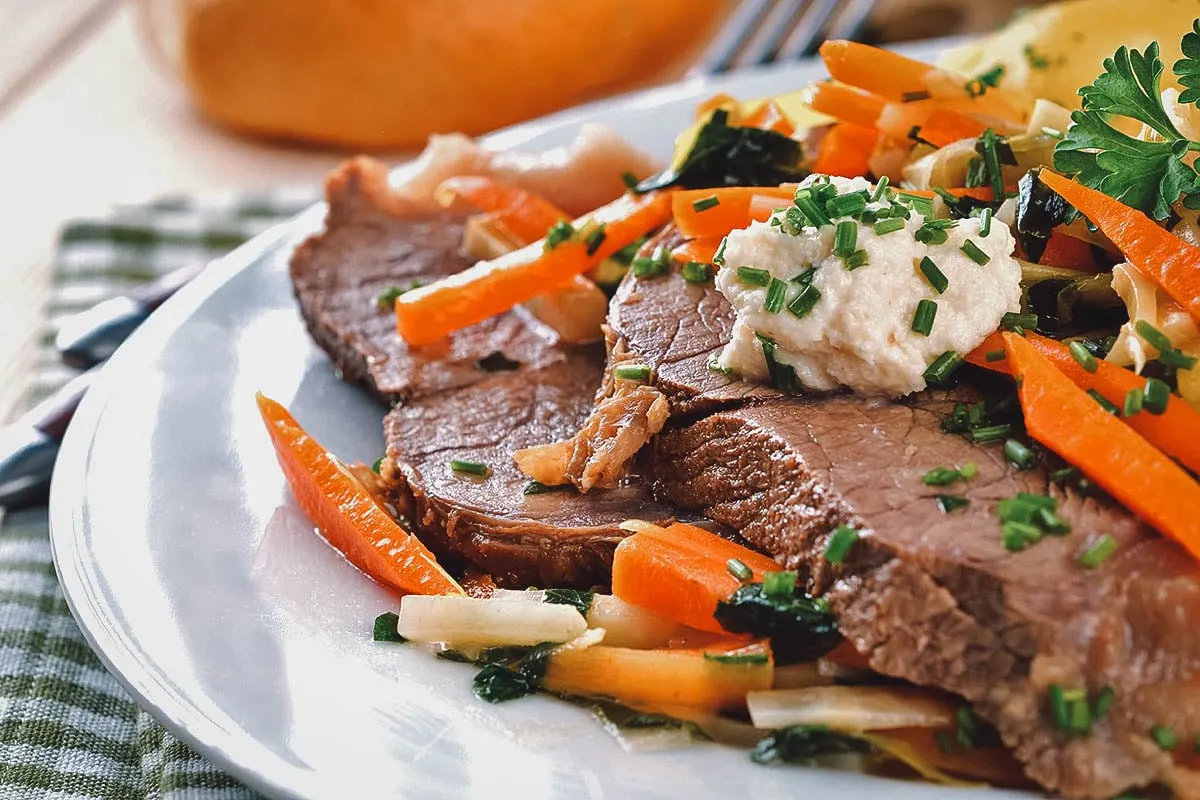
Photo by Karl Allgaeuer
DESSERTS / DRINKS
9. Apfelstrudel (Austrian Apple Strudel)
Austrian apfelstrudel is the original version of this popular European dessert that’s spread well beyond Austria’s borders. It refers to a baked dish of rolled dough stuffed with an apple filling.
Austrian apple strudel can be made from filo pastry, quark dough, yeasted dough, or potato dough. Sometimes, it can be made with shortcrust pastry as well, especially in Tyrol. The filling consists of cubed or grated apples, raisins, and buttered breadcrumbs flavored with ground cinnamon and granulated sugar.
Apfelstrudel is served warm, often with a dusting of powdered sugar or a side of vanilla ice cream, vanilla sauce, or whipped cream. The strudel is a fixture on the menus of mountain huts, restaurants, and rustic Austrian cafes across the country. It’s delicious at any time of the year but especially during the fall when apples are in season.
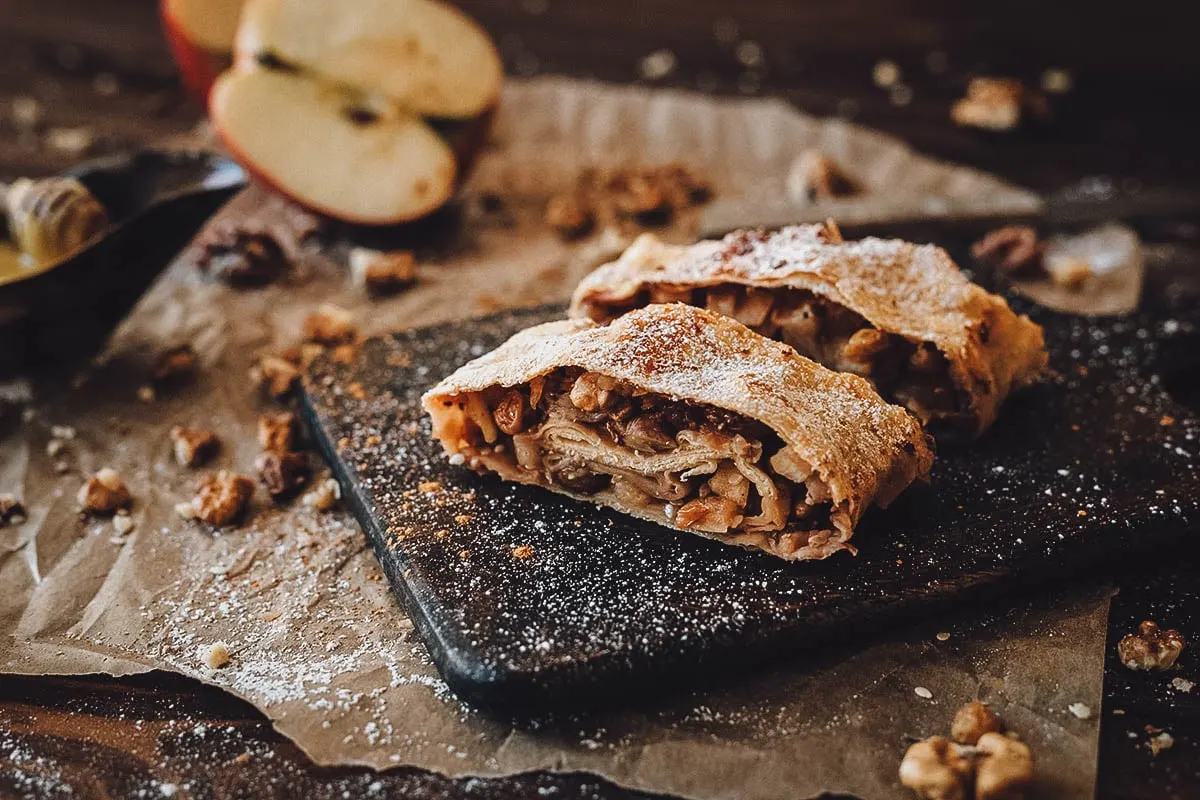
Photo by La Bella Studio
10. Kaiserschmarrn
Kaiserschmarrn is one of the most famous desserts in Austrian cuisine. It’s named after the Austrian Kaiser – Emperor Franz Joseph I – who was a real fan of the dish.
Kaiserschmarrn is made with a fluffier and thicker pancake batter that’s baked in a pan with butter. When the bottom firms up, you break it up with a spatula into smaller pieces and do this repeatedly until it’s done.
Traditionally, this delicious Austrian dessert is served with icing sugar and roasted plums (or plum jam) but today, it’s common to see it served with apple sauce, Nutella, and other kinds of fruit jam. You can even find varieties that are caramelized during baking, or made with raisins or almonds.
Aside from being a popular homemade dish, kaiserschmarrn is a common sight on restaurant and cafe menus throughout Austria.
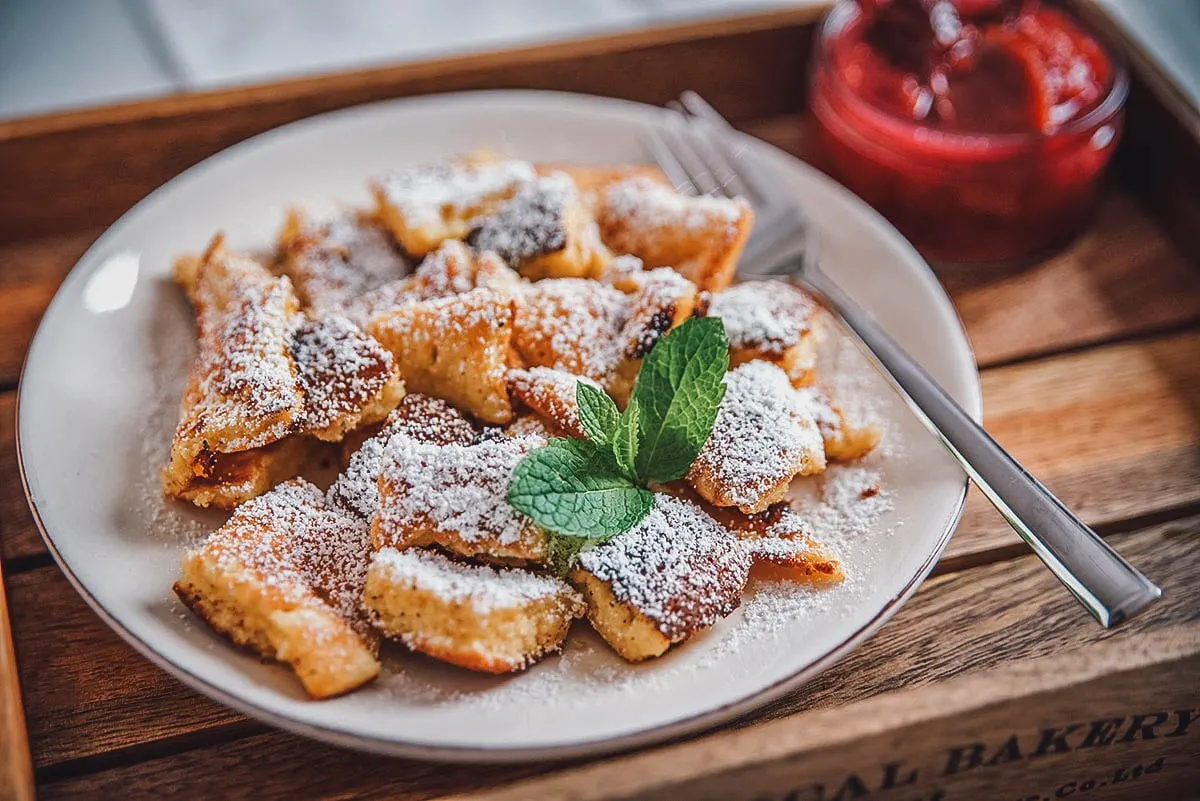
Photo by A_Lein
11. Palatschinken
Palatschinken refers to Viennese-style dessert crepes or pancakes that are traditionally filled with apricot jam.
Palatschinken batter is made from eggs, flour, milk, and sparkling water. The sparkling water is what gives palatschinke their characteristic lightness. A spoonful of batter is cooked evenly in a thin layer on a pan before being filled with apricot jam and rolled up.
Aside from apricot jam, palatschinke can also be made with other fruit jams, Nutella, coconut, bananas, ground nuts, sugar, and lemon. They can be rolled up or folded into triangles before being dusted with powdered sugar and served.
These Austrian pancakes are a delicious treat that’s commonly served at cafes and pastry shops. A perfect accompaniment to coffee, they’re also a popular homemade treat.
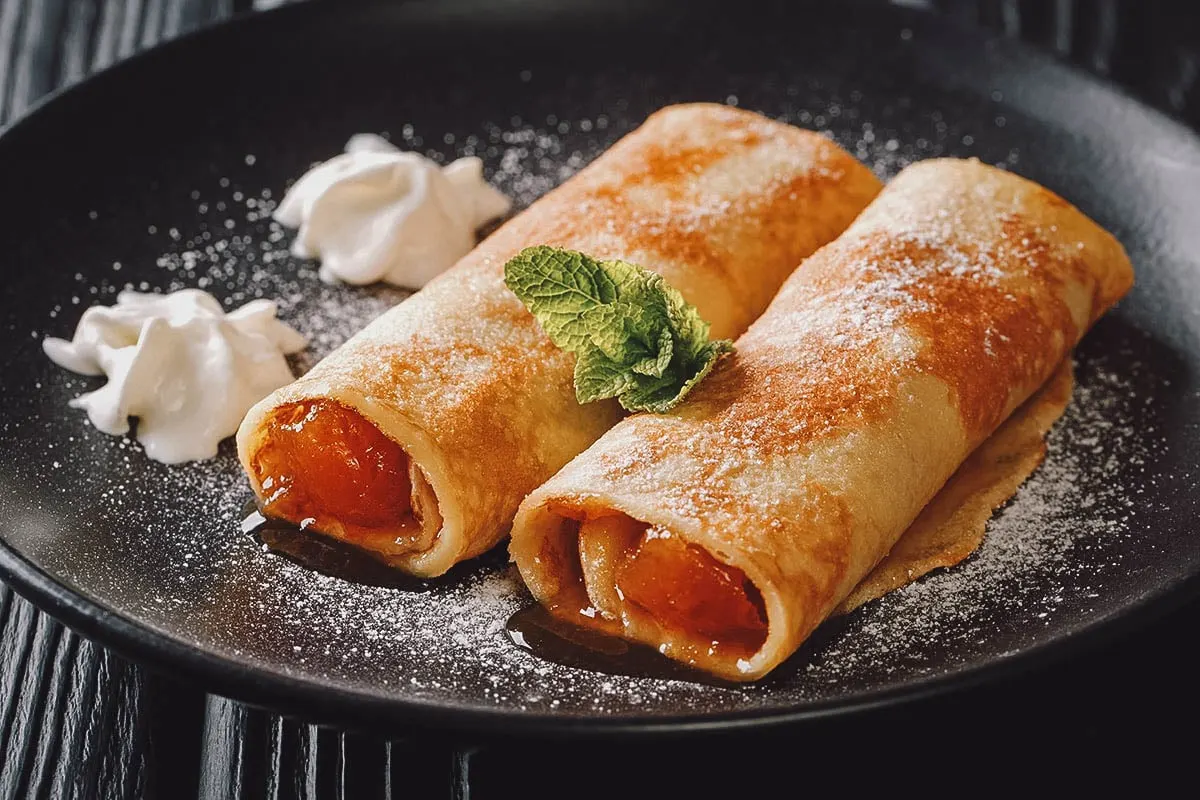
Photo by Sergii Koval
12. Powidltascherl
Powidltascherl are dumplings made from potato dough filled with plum jam. The word powidl comes from the Czech language and refers to a type of plum jam that’s made without additional sugars.
To make powidltascherl dough, cooked potatoes are put through a potato ricer and then mixed with semolina flour, salt, nutmeg, eggs, and butter. The dough is rolled out and cut into circles before being folded into half-moon shapes over dollops of plum jam. The dumplings are then cooked in boiling water.
These delicious plum jam turnovers are sprinkled with icing sugar and served with breadcrumbs browned in butter and granulated sugar.
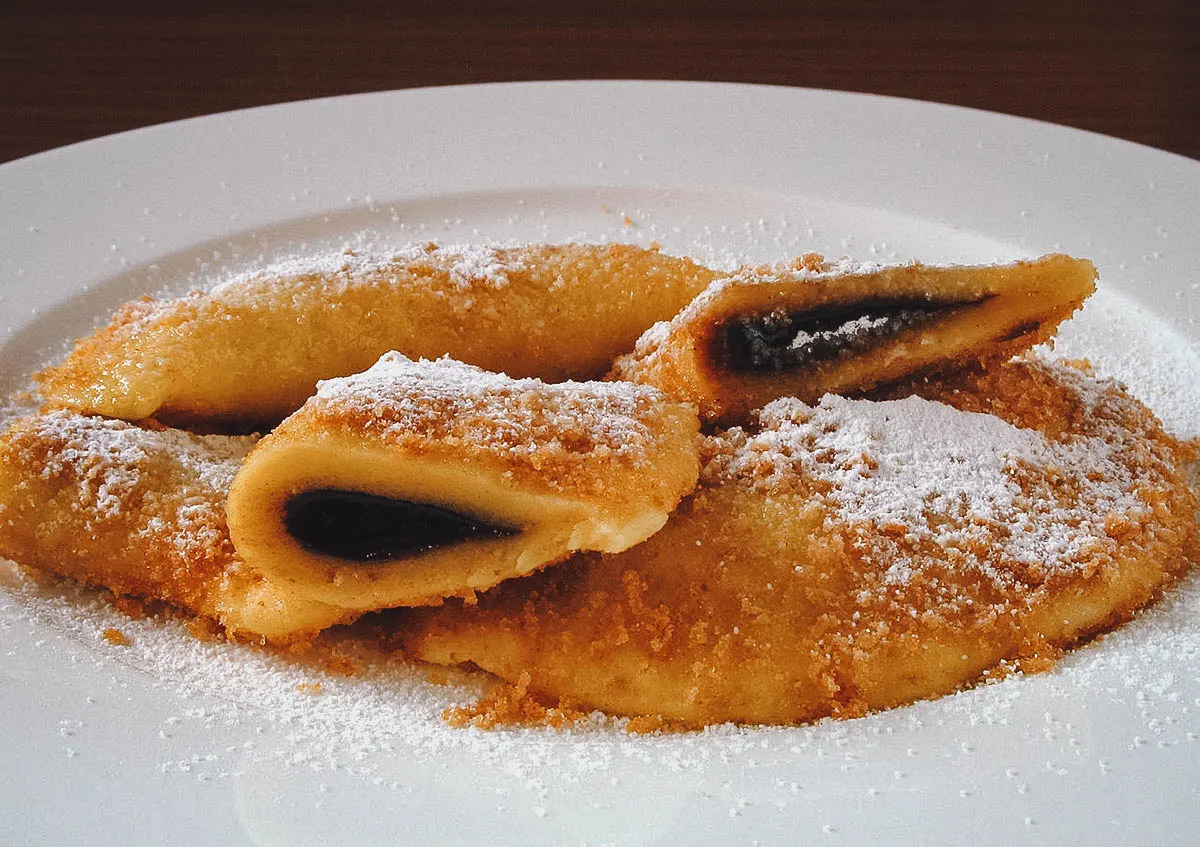
Photo by Kobako, CC BY-SA 3.0, via Wikimedia Commons / Processed in Photoshop and Lightroom
13. Marillenknödel
Marillenknödel are Austrian dumplings made from potato, cottage cheese, or flour dumpling dough stuffed with apricot halves. A popular dish in Bavarian cuisine, they’re especially common in the apricot-growing regions of Wachau and Vinschgau.
To make marillenknödel, balls of dough are formed into balls. The balls are flattened and stuffed with a pitted apricot half along with a sugar cube or one teaspoon of sugar. The dumplings are then closed and cooked in boiling water. When ready, they float to the surface.
After cooking, the dumplings are served with melted butter and a sprinkling of powdered sugar. Sometimes, they’re served with cinnamon sugar, poppy seeds, or gingerbread crumbs.
Most Austrians typically enjoy apricot dumplings at home. If they’d rather not make them from scratch, then they can buy frozen or ready-made dumplings from the supermarket. However, these store-bought versions are typically made with apricot marmalade instead of actual apricot halves.
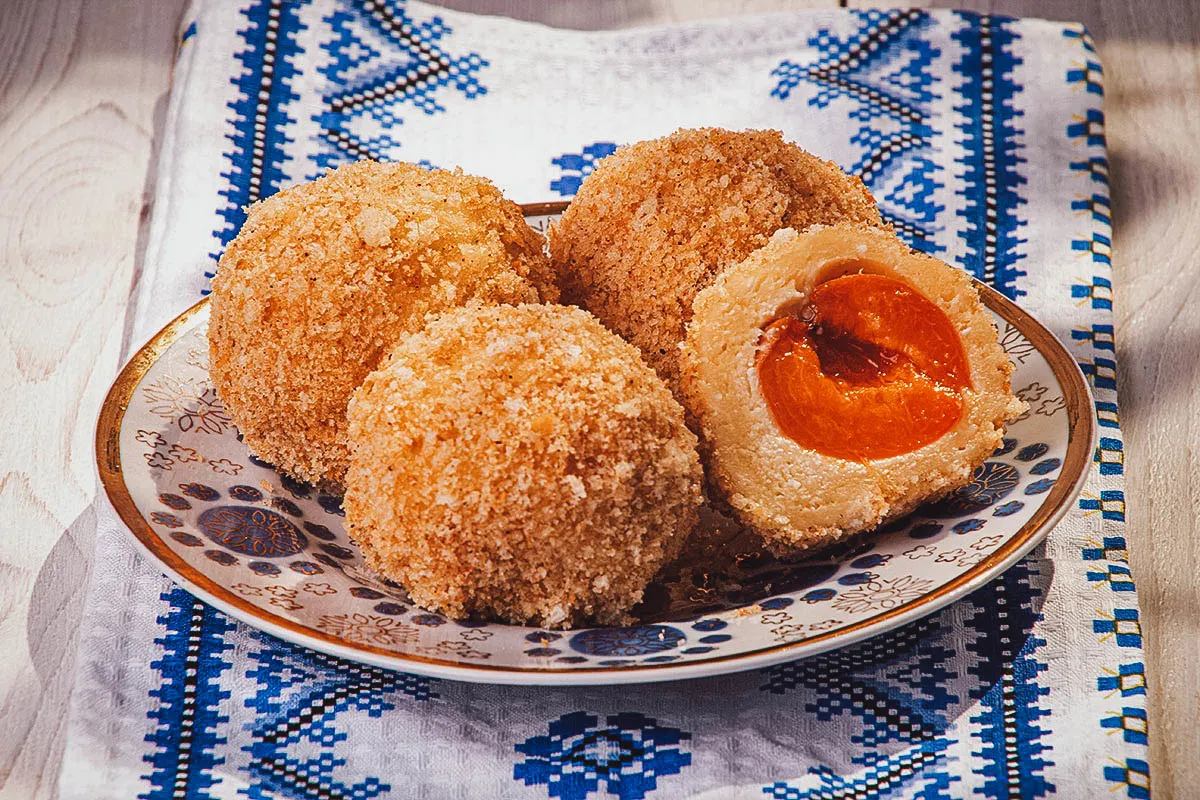
Photo by karamba70
14. Salzburger Nockerl
Salzburger nockerl refers to a sweet souffle originally from Salzburg. While the dish is usually served as a dessert, it’s filling enough to be eaten as a main course.
Salzburger nockerl is made from a dough consisting of egg yolks, flour, sugar, and vanilla sugar. Leftover egg whites and sugar are whisked into a meringue and added to the dough carefully so as not to break the meringue. The mixture is then piped into a dish and baked until golden brown.
This delicious Austrian souffle is always made fresh and served with a sprinkling of icing sugar. Sometimes, they can be served with raspberry sauce or vanilla sauce.
Salzburger nockerl is a tasty treat and a must when visiting Salzburg. Forget about Mozartkugeln and go for this instead. You won’t be disappointed.
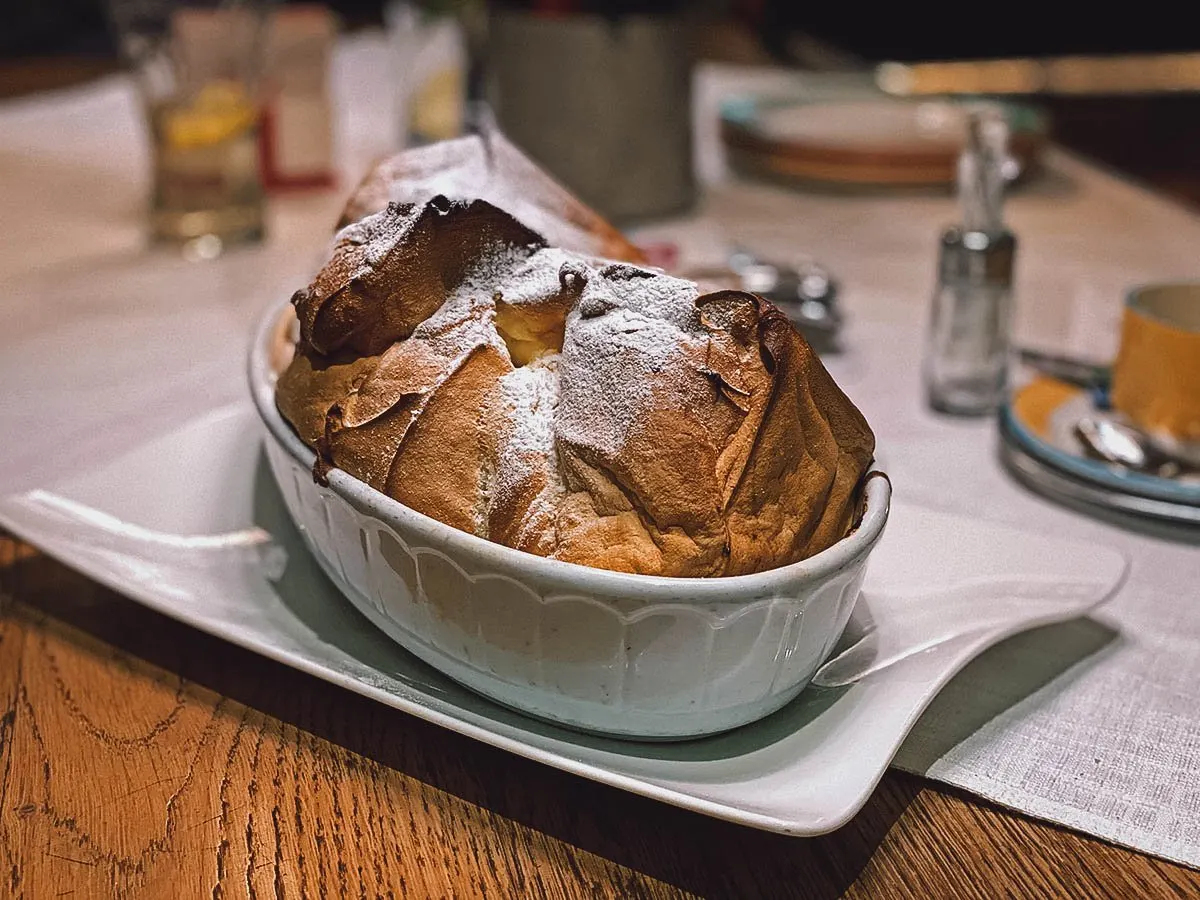
Photo by fivetonine
15. Sachertorte
This chocolate sponge cake with apricot jam and chocolate glaze is one of the most famous cakes in Viennese cuisine. It was invented by Franz Sacher in 1832, who was working as an apprentice at the court.
The original recipe for sachertorte is a closely guarded secret but Hotel Sacher has released an approximate recipe that gives us an idea of how it’s made. First, butter, sugar, and vanilla seeds are whipped into a cream before adding egg yolks and melted dark chocolate. Egg whites are whipped separately with sugar and then added in parts to the chocolate butter mixture with flour.
The cake is baked and allowed to cool before being sliced in half and spread on both sides with jam. The cake is reassembled, chilled, and poured over with chocolate glaze that’s quickly spread with a spatula. The cake is then chilled again so the chocolate glaze hardens a bit and the flavors mix. When ready, it’s typically served with a garnish of unsweetened whipped cream.
You can still taste the original versions of sachertorte in Vienna. The version described here is taken from the published recipe of Hotel Sacher. The other original version can be tasted at the pastry shop Demel, where Franz Sacher’s son Eduard completed his father’s work.
Versions of sachertorte can be enjoyed at many other pastry shops in Vienna, across Austria, and throughout many parts of Europe.
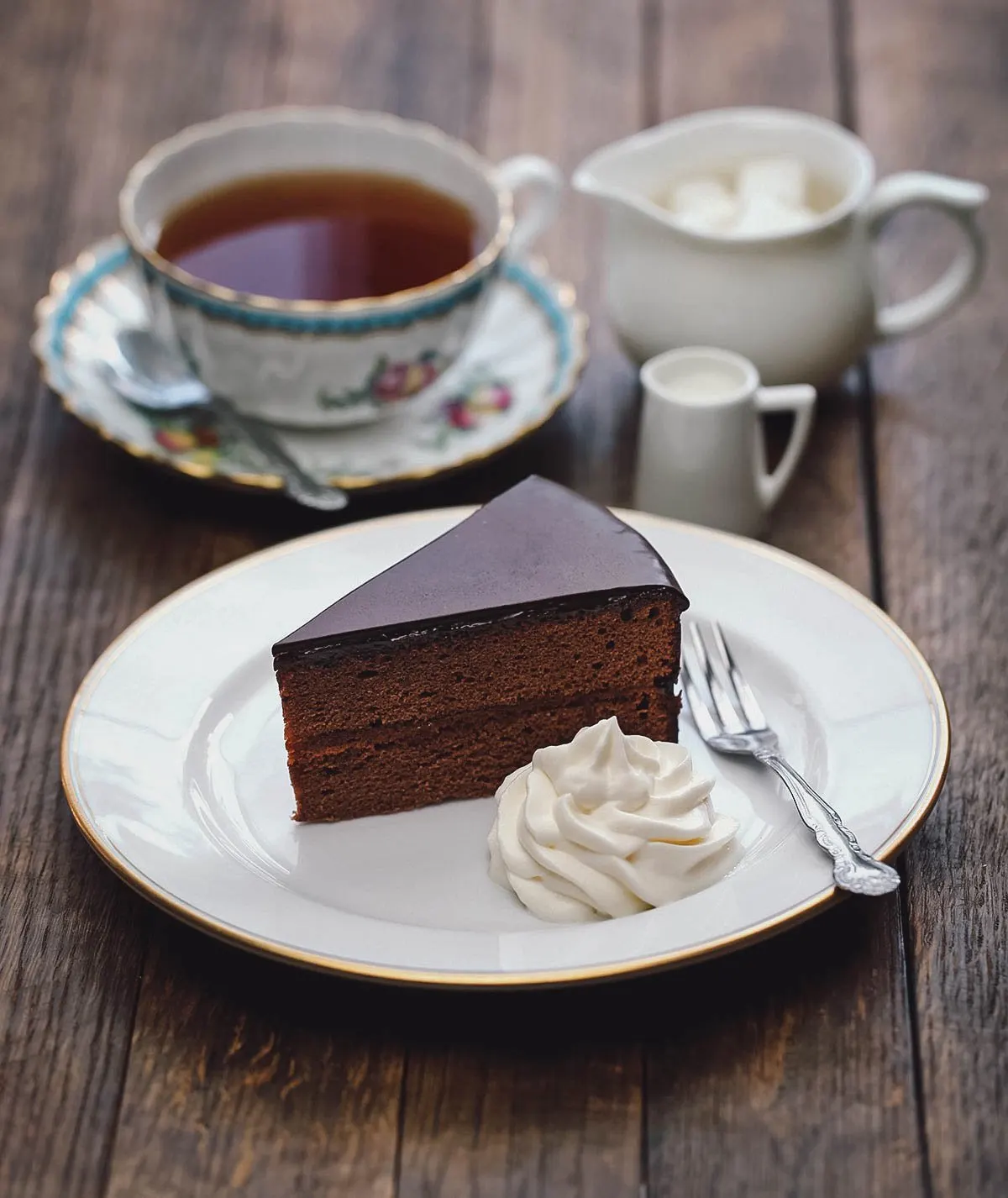
Photo by bonchan
16. Linzer Torte
Linzer torte is a cake named after Linz, a town in Upper Austria. It consists of a shortcrust pastry with ground nuts, topped with a layer of red currant jam and a decorative lattice topping.
Shaped into a circle, the shortcrust dough is made from flour, sugar, butter, eggs, ground nuts, cinnamon, and cloves. It’s traditionally topped with red currant jam though it can also be topped with other jams like apricot or raspberry.
A decorative thin lattice is placed over the jam before it’s brushed with lightly beaten egg whites and then baked. Cooking the jam with the cake gives it a lovely sticky consistency, while also imparting flavor to the pastry.
Linzer augen (literally “Linzer eyes”) is a type of sandwich cookie with the flavors of Linzer torte. The cookies are circular, flower-, or star-shaped with a cutout in the top cookie, creating the symbolic “eye”. They’re dusted with powdered sugar before serving.
Linzer torte and Linzer augen are both commonly found in cafes and pastry shops across Austria, while commercial versions are also sold at supermarkets.
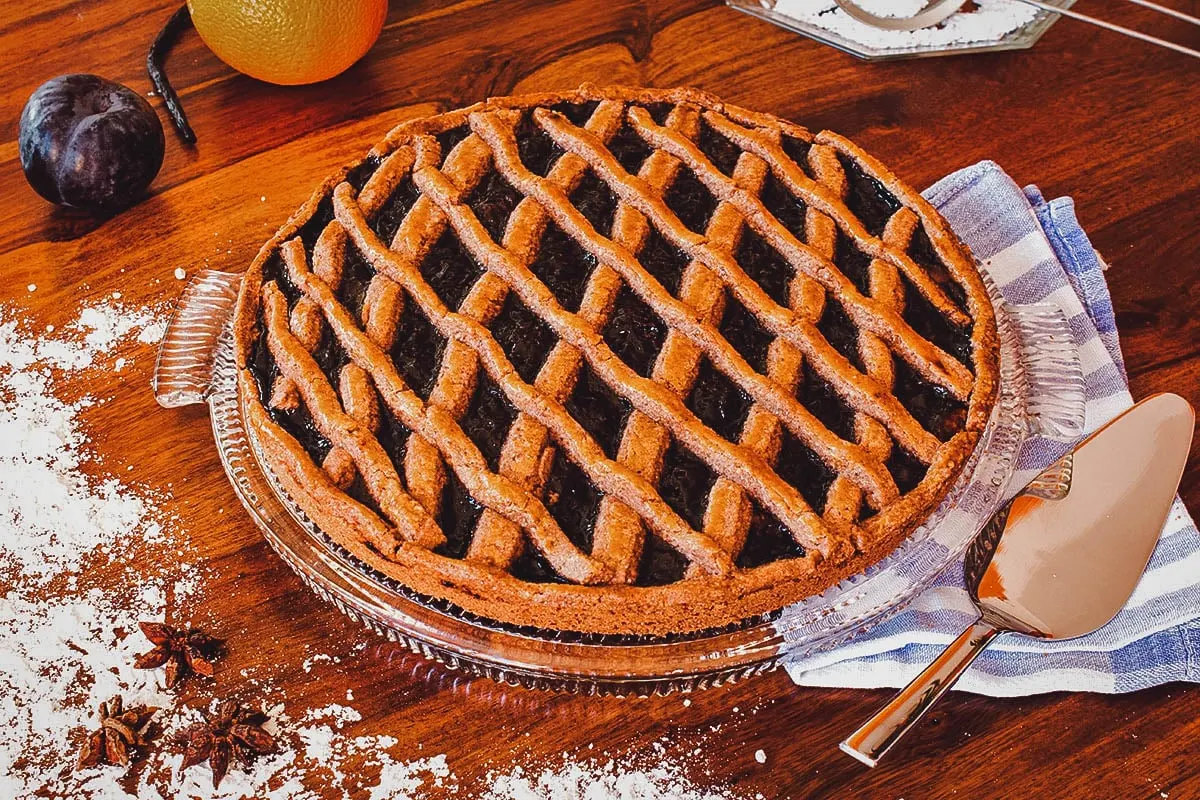
Photo by pixdesigned
17. Cremeschnitte
Cremeschnitte literally translates to “cream slice” and refers to a dessert originating from the Viennese baking tradition. It consists of two layers of puff pastry, a thin layer of apricot jam, and a generous portion of vanilla-flavored pastry cream, which gives the desert its name.
Every bakery and pastry shop has its own recipe for cremeschnitte (which they swear by), but in general, it’s made like this.
First, you make the puff pastry (or buy it). You roll out the sheet of puff pastry to your desired size and cut it in half before baking. Meanwhile, you mix vanilla seeds, egg yolks, whole eggs, granulated sugar, vanilla sugar, rum, and salt over a bain-marie and whisk until fluffy. Add gelatine and whipped cream to create a light vanilla-flavored cream.
After your pastry sheets have finished baking, spread a thin layer of jam on both sheets before laying one at the bottom of your mold. Pour the vanilla cream over the pastry sheet before placing the second sheet on top. Glaze the top sheet with fondant icing before serving.
Personally, cremeschnitte is one of my favorite Austrian desserts. It’s a rich and delicious dessert that you should definitely seek out in Austrian pastry shops.
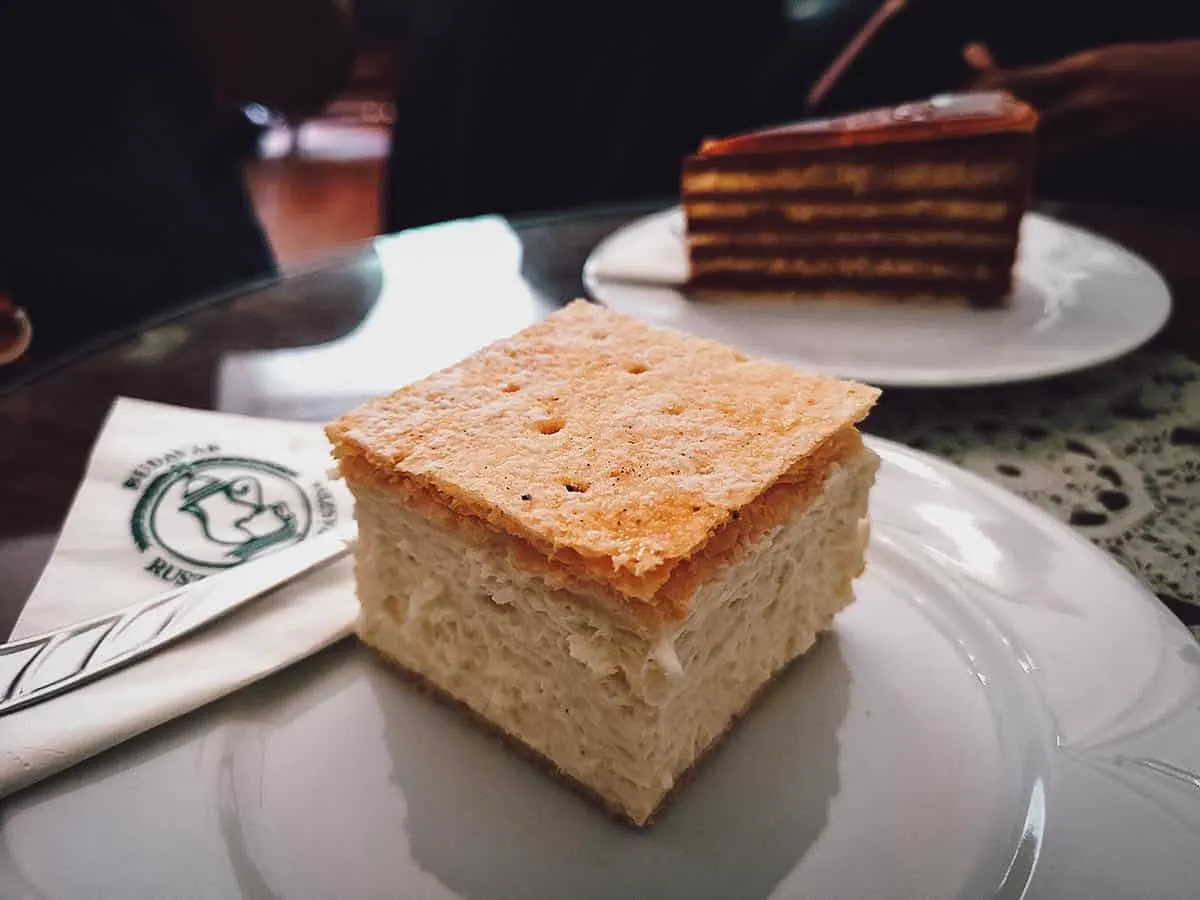
18. Krapfen
Krapfen refers to a variety of yeasted doughnuts without holes. The sweetened enriched dough is a brioche-style dough, enriched with a good quantity of butter, eggs, and sugar.
The dough is made and left to proof before being rolled out and cut into circular shapes. They’re then fried on both sides to achieve the signature doughnut ring.
Traditional Austrian carnival doughnuts called faschingskrapfen are always filled with apricot jam. Krapfens are common throughout Austria but they’re especially popular in Carnival season.
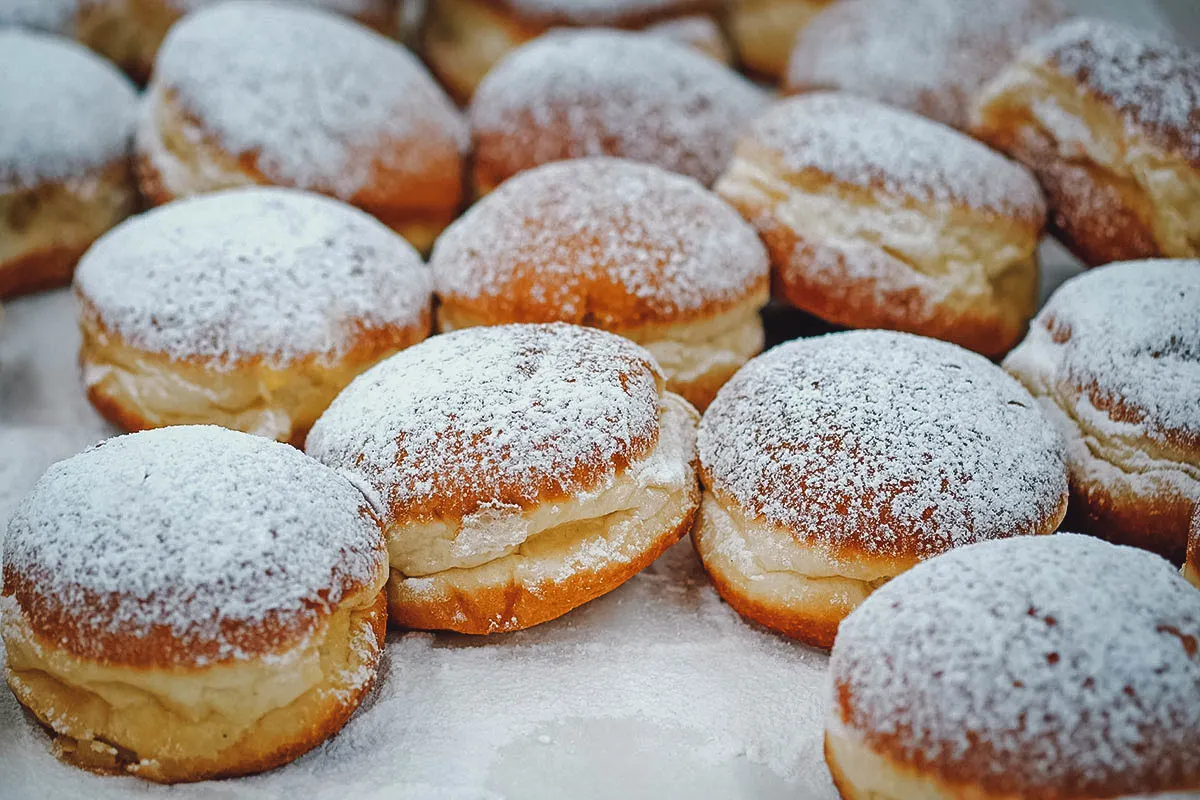
Photo by tanyki88
19. Vanillekipferl
Vanillekipferl are small, crescent-shaped Chritsmas biscuits originating from Austria, but they can be found in Germany, Switzerland, Czechia, Slovakia, Poland, and Hungary as well. They’re well-known across Europe and commonly sold at Viennese coffee shops.
Vanillekipferl look easy to make but they’re actually quite challenging. They’re traditionally made with shortcrust pastry consisting of ground walnuts, flour, butter, and sugar. The dough is kept cool before being shaped by hand, which is tricky because vanillekipferl dough is very crumbly. You have to be careful not to break the biscuits.
The biscuits are baked in an oven and dusted with a generous amount of vanilla-flavored icing sugar, which gives the biscuits their characteristic flavor and appearance. When made well, these melt-in-your-mouth biscuits are a delight to eat with coffee or tea.
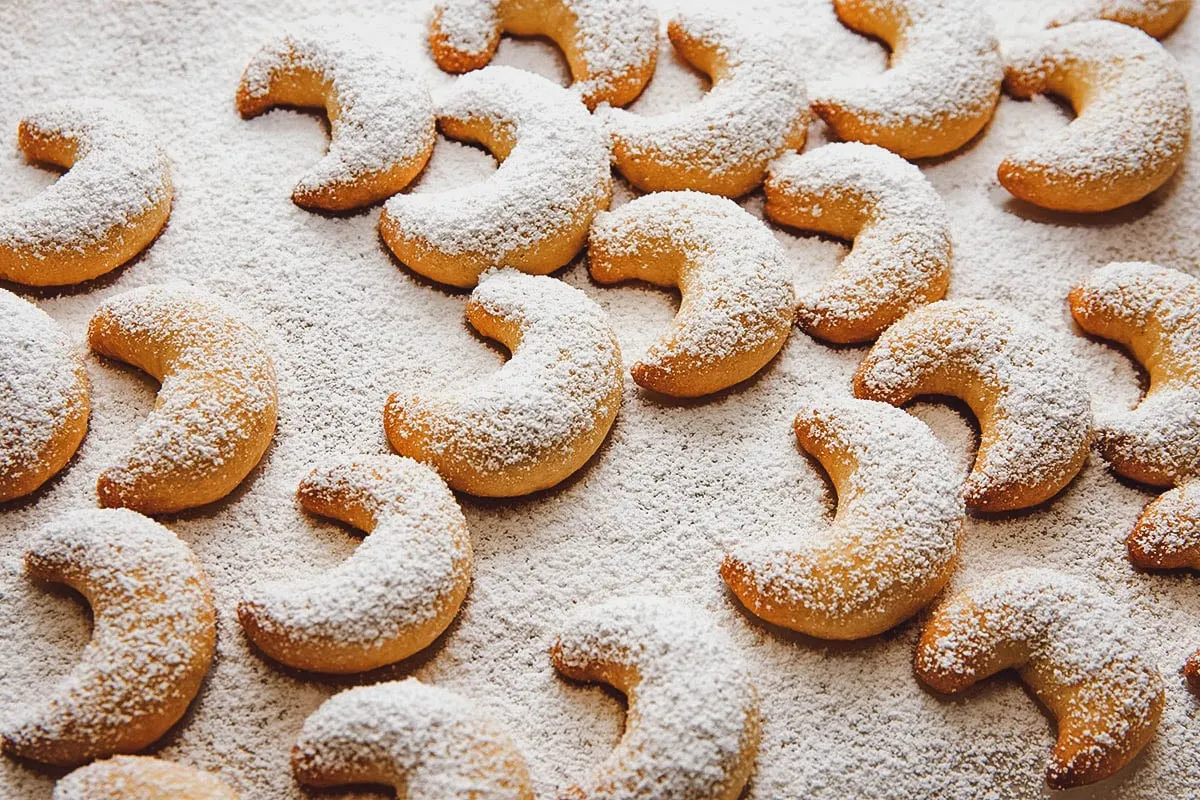
Photo by Olinda
20. Einspänner Coffee
Einspänner refers to a coffee drink that originates from the Viennese coffee tradition. It consists of a shot of espresso or regular black coffee topped with whipped cream.
Einspänner coffee was named after the one-horse carriage of the same name. The driver would hold the coffee in one hand and the reins in the other. Because the coffee is topped with thick cream, it would stay warm and could be enjoyed while the driver was on break.
Traditionally, einspänner coffee isn’t mixed but sipped through the cold cream. It’s available at pretty much every coffee shop in Austria.
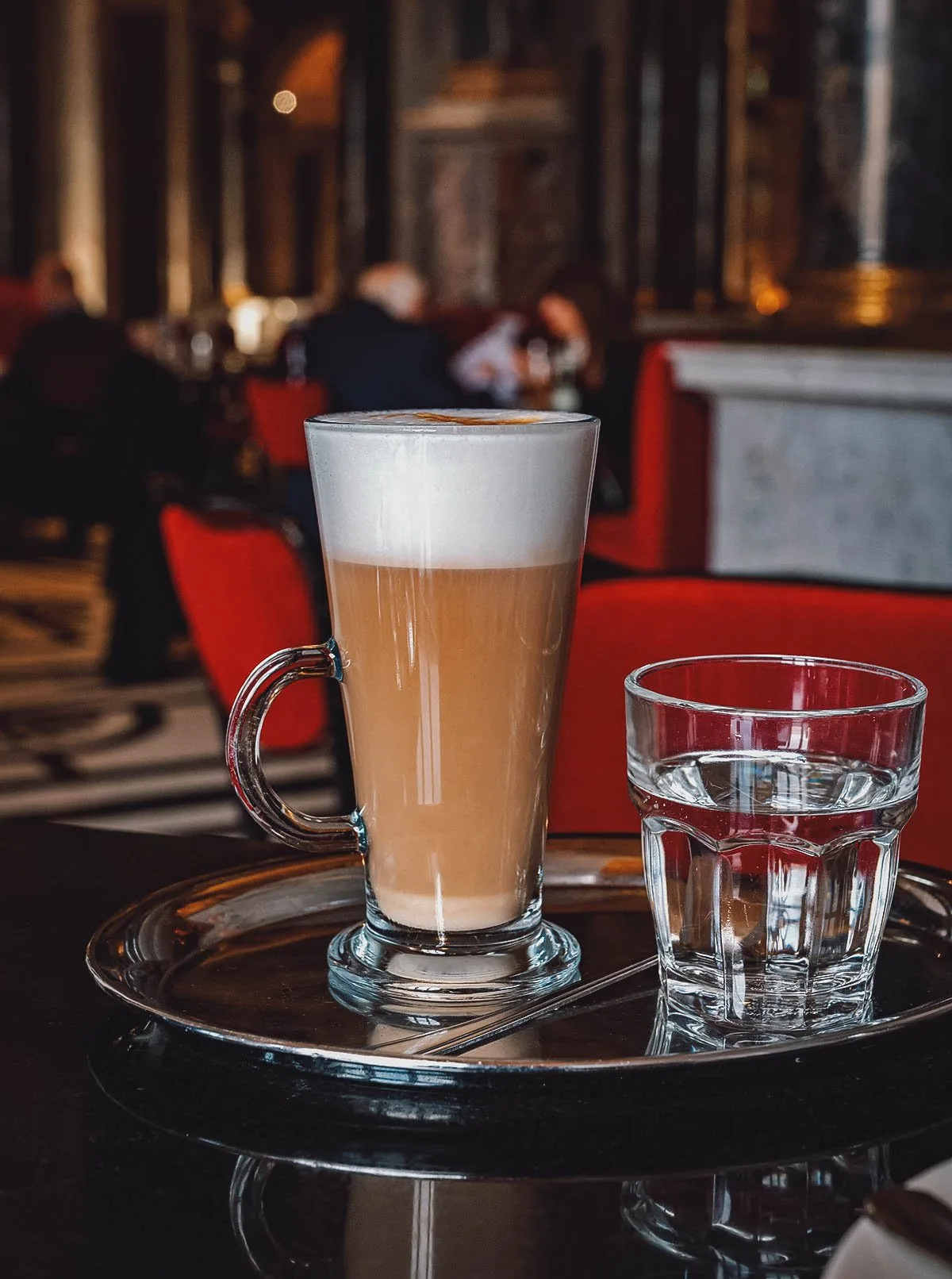
Photo by barmalini
FINAL THOUGHTS ON TRADITIONAL AUSTRIAN FOOD
As you can tell from this collection of the most popular Austrian dishes, the Austrian culinary tradition is rife with delicious desserts and hearty comforting dishes. If sweets and comfort food excite you, then you’ll have lots to look forward to when you visit Vienna and Austria.
Like many comfort foods, some of the tastiest Austrian delicacies are best when made at home. Luckily for you, many restaurants and home-style inns do come very close to Austrian home cooking.
Disclosure
Some of the links in this article on typical Austrian food are affiliate links, meaning we’ll earn a small commission if you make a booking at no added cost to you. We really appreciate your support as it helps us write more of these free travel and food guides. Thank you!
Cover photo by Tatiana Bralnina. Stock images via Shutterstock.

